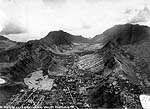| |
Chronology
This section includes an outline of people and events related to Nu‘uanu
following the Mahele. As Nu‘uanu represents the history of the
Hawaiian Monarchy in particular, there is emphasis on the changing rulers
of the Kingdom and events that affected the Kingdom politically. |
| |
Mauna ‘Ala
In the 1860s a new Royal Mauseleum was built in lower Nu‘uanu,
and became thereafter the burial place for the Hawaiian royal families.
Mauna ‘Ala, as this site is named, became a new sacred space for
Hawaiian people. We will hear its story from the ancestral caretaker,
Bill Maioho. |
| |
Overthrow of the Monarchy
More than any event, the overthrow of the Hawaiian Monarchy and the
annexation of the Islands to the United States changed what could and
would be done--and by whom--in the islands. As the seat of government
and the residence of the royal families, Nu‘uanu and Honolulu are
the setting for this transformation. |
| |
Hanai-a-ka-malama
As both Hawaiian and Western leaders move up into Nu‘uanu, the
landscape becomes transformed by large and gracious houses. Among these
is Queen Emma's Summer Palace. Many of these grand homes still exist
today, but their uses have changed, reflecting the changing role of
Nu‘uanu and the Geography of Honolulu. |
| |
Growing Up
Kalani paints a picture of life in Nu‘uanu in the mid-20th
century, with stories of her parents and her childhood, and of growing
up in Nu‘uanu as a Hawaiian. |
| |
The Highway
The most recent and most physically dramatic change to Nu‘uanu
has been the building of the Pali Highway in the 1960s. Together with
the influx of tourists and the growth of suburbs in Ko‘olaupoko,
this development has tremendously transformed the character of this
valley. |














